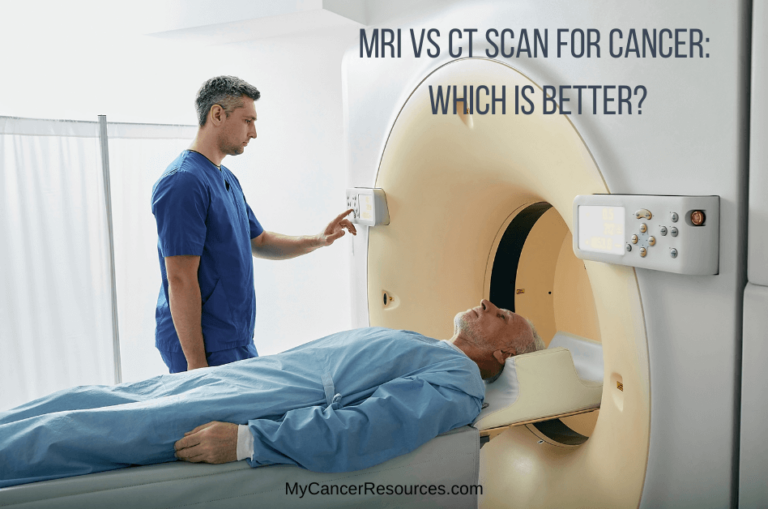
You might have heard the terms MRI and CT scan, but you might not be familiar with what each is and when each is used. This article explores an MRI vs CT scan for cancer and helps you understand how each provides a picture of what’s going on inside your body. Each scan has a similar purpose, to take detailed images of the body, but each scan is done differently and provides unique information to your healthcare team.
A main difference between MRI and CT scan is the way in which the machines take their pictures.
CT Basics
CT stands for computed tomography. Sometimes called a CAT scan, it uses X-rays from different angles to produce a cross-sectional image of your bones and organs. CTs are best used to take detailed pictures of organs, bones, and other dense areas of the body.
CT scans can be done with or without contrast. Contrast material is a fluid that’s injected into your veins to provide even better detail in the CT images. Before a CT scan, you can be injected with contrast dye, and that will help the radiologist (the doctor reviewing the images) by highlighting where something might be off in a part of the body. For example, a CT with contrast can detect liver cancers because it highlights abnormal blood flow patterns often caused by tumors.
CT scans are usually the first imaging test done in order to stage cancer. This tells you how big a tumor or tumors are, and if they have spread to other areas of the body. Staging and grading cancer helps your healthcare team decide on a treatment plan.
MRI Basics
MRI stands for Magnetic Resonance Imaging. MRI scanners use a strong magnetic field and radio frequencies to take images of soft tissues. Unlike CT scans that use X-rays, they create their images based on the movement of water molecules in your tissues.
If a brain tumor is suspected, or if there is reason to believe a tumor has spread to your brain, doctors will request an MRI because these machines are so good at recognizing even the most subtle differences in soft tissue, including the brain. MRIs may also be the preferred type of imaging for prostate cancer and breast cancer, in order to clearly see differences between normal and diseased tissue.
Like CTs, MRIs can also use contrast dye to get a better image, but this is not always used.
Weighing the Risks: Radiation and Safety
It’s important to understand the risks associated with an MRI vs CT scan for cancer diagnosing and treatment. A CT scanner emits ionizing radiation that can potentially increase one’s cancer risk when used often over time.
The radiation exposure from CT imaging must be weighed against its benefits in creating precise images. Since there is the likelihood of having repeated scans throughout the cancer journey to see how the tumors are responding to treatment, or to detect if a recurrence has occurred, you should talk with your health care team about the risks vs. benefits in using CT scans.
MRI scans use radio waves and strong magnets rather than radiation to create images. This makes MRIs a safer imaging option for those wanting to avoid radiation exposure. However, as I’ve already mentioned, sometimes CT scans are better options for imaging certain parts of the body.
Navigating Challenges: Claustrophobia and Implants
Undergoing an MRI can be a challenging experience if you have claustrophobia or anxiety in tight spaces.
The design of traditional MRI machines requires the body be fully immersed in a narrow tube, which may create discomfort and an overwhelming sense of being confined.
Sometimes an MRI machine makes a loud noise as part of the scanning process, and this can also be upsetting to some people.
Know that these feelings are valid and quite common. Remember that medical staff are on hand to support you through the process with explanations, comfort measures, and, in some cases, mild sedation.
I’ve also written an article on tips for overcoming MRI anxiety that may also be helpful for you as you prepare for an MRI.
For those with metal implants like cardiac pacemakers, artificial joints, or surgical clips, MRIs create additional complications. The powerful magnetic fields generated by an MRI machine can interfere with these devices or cause serious harm if you have metal objects in your body. You must tell your healthcare provider about any implants prior to the scan, so they can recommend safe, alternative imaging tests if needed.
More and more facilities now offer open MRI machines. These offer a bigger space, which can help reduce feelings of claustrophobia. While open MRIs can be a good alternative, the image quality may not be as high as those from traditional MRIs.
Talk with your doctor the about the best imaging option for your specific medical needs and personal comfort level.
Making The Choice: MRI vs CT Scan for Cancer?
Doctors decide which imaging test to use based on each patient’s circumstances. In deciding if a CT or MRI is preferred, they consider the type of cancer you’re facing, its location in your body, and the current stage to which it has progressed.
For instance, staging cancers that have metastasized often requires a CT scan because it does so well in imaging your entire body for any spread of disease. However, when detail is needed to assess complex areas, such as your brain or spine, your doctor may lean towards an MRI.
An MRI provides better images of soft tissue, as it picks up on subtle differences between healthy and cancerous tissues. Soft tissue contrasts are particularly helpful for looking at brain tumors, liver cancers, and the central nervous system. Also, if CT results are unclear, an MRI can then be used to provide greater detail about an area of concern.
CT scans are completed faster and are preferred if you have implants or other medical devices. This speed and compatibility can be vital when immediate results are necessary. In urgent situations where time is of the essence, a CT scan can quickly provide the information needed to determine your treatment plan.
Your doctor will balance factors like these to decide the most informative and safe imaging test for your diagnosis and ongoing disease management.
Finding the Right Scan
You play a critical role in your cancer journey, including participating in the decisions around diagnostic imaging.
Understanding the purpose and process behind each type of scan empowers you to be an active participant in your treatment. Remember, precision in identifying and assessing your cancer can greatly influence the effectiveness of your treatment plan.
Ask your medical team about the reasons for selecting a particular imaging test, whether a CT scan or an MRI. Learn how the recommended method provides the best insights into your health. Ask about the advantages the scan offers in terms of image quality and detail required for your situation.
Being well-informed ensures that, together with your healthcare providers, you utilize the most appropriate scan.
Your comfort and well-being are super important. If you are concerned about the scan, such as feeling anxious in small spaces, don’t hesitate to voice these concerns. Your medical team can discuss alternatives with you, such as the use of an open MRI or sedation options, ensuring that you remain comfortable and safe throughout the imaging procedure.
Be sure to also discuss options if you have medical implants, to make sure you are using the safest scanning option for you.
You can work together with your medical team to make the best decisions on types of scans to use and when.



